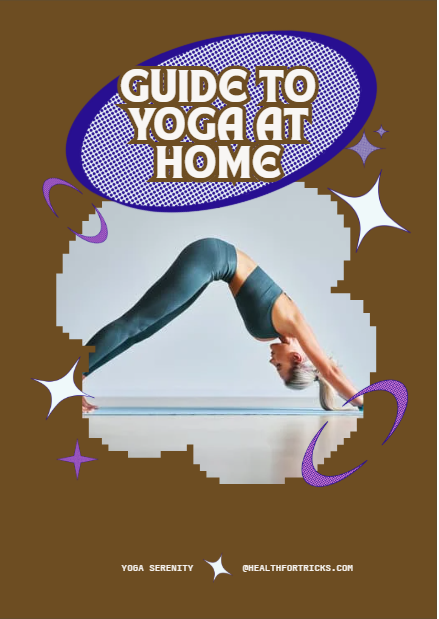In today’s fast-paced life, following a proper Guide to Yoga at Home has become more important than ever. Finding time to visit a yoga studio can be challenging with our busy schedules, work-from-home setups, and family commitments. Fortunately, you can experience all the incredible benefits of yoga without stepping outside. Whether you want to improve flexibility, reduce stress, strengthen your body, or increase mindfulness, practicing yoga at home can truly transform your lifestyle. This comprehensive Guide to Yoga at Home will walk you through everything you need to get started — from setting up your space and choosing the right gear to learning basic poses and building a sustainable routine that fits your life.
Why Practice Yoga at Home?
Yoga at home offers convenience, flexibility, and comfort. Here are a few benefits of starting your practice at home:
- Saves time and money: No need for a gym membership or travel time.
- Privacy and comfort: You can practice in your own space, without feeling self-conscious.
- Consistency: You can choose your schedule and stick to it.
- Personalization: Focus on poses and flows that suit your body and goals.
What You Need to Start Yoga at Home
The best part about Guide to Yoga at Home is that you don’t need much to get started. Here are the essentials:
1. Yoga Mat
Invest in a good-quality non-slip mat that provides cushioning and support.
2. Comfortable Clothing
Wear breathable and stretchy clothes that allow free movement.
3. Quiet Space
Find a calm, clutter-free space in your home with enough room to stretch out.
4. Yoga Props (Optional)
Blocks, straps, and bolsters can support your practice, especially as a beginner.
5. Water Bottle
Stay hydrated before and after your session.

Choosing the Right Style of Yoga
There are various types of yoga. As a beginner, you should explore different styles to find what suits you best.
- Hatha Yoga: Great for beginners; focuses on basic poses and breathing.
- Vinyasa Yoga: More dynamic and flow-based; good for building stamina.
- Yin Yoga: Slow-paced; excellent for deep stretching and relaxation.
- Restorative Yoga: Very gentle; ideal for stress relief and recovery.
- Power Yoga: A more athletic version for strength and flexibility.
Learn Basic Yoga Poses
Start with foundational poses to build confidence and body awareness. Here are a few beginner-friendly Guide to Yoga at Home poses:
1. Mountain Pose (Tadasana)
Stand tall, feet together, hands at your side. Focus on posture and balance.
2. Downward Facing Dog (Adho Mukha Svanasana)
Hands and feet on the mat, hips raised, forming an inverted V. Stretches back and legs.
3. Cat-Cow Stretch (Marjaryasana-Bitilasana)
On all fours, alternate between arching your back (cow) and rounding it (cat).
4. Child’s Pose (Balasana)
Kneel and fold forward with arms stretched. A restful pose to relax the spine.
5. Warrior I & II (Virabhadrasana)
Lunging postures that build strength, balance, and focus.
6. Cobra Pose (Bhujangasana)
Lie on your belly, press palms down, and lift the chest. Opens chest and strengthens spine.
Build Your Yoga Routine
To stay consistent, develop a routine that fits into your daily life at Guide to Yoga at Home.
Tips to Create a Yoga Routine at Home:
- Start small: Begin with 15–20 minutes a day.
- Set a fixed time: Mornings or evenings are ideal.
- Follow online classes: Use YouTube or apps with guided sessions.
- Track your progress: Keep a journal or use a calendar to stay motivated.
- Listen to your body: Avoid pushing too hard and take breaks when needed.
Breathing and Mindfulness in Yoga
Yoga is not just about movement — breathing is equally important.
Basic Breathing Techniques:
- Ujjayi Breath: A deep, controlled breath that helps in focus and calmness.
- Nadi Shodhana (Alternate Nostril Breathing): Balances energy and promotes relaxation.
Mindfulness during yoga helps connect your mind and body. Try to focus your attention on your breath and how your body feels in each pose.
Mistakes to Avoid When Practicing Yoga at Home
Starting guide to yoga at home is simple, but avoid these common mistakes:
- Skipping warm-ups: Always begin with gentle stretches to prepare your body.
- Doing advanced poses too soon: Stick to beginner poses before moving to advanced levels.
- Ignoring alignment: Poor posture can lead to injury.
- Inconsistency: Practice regularly, even if it’s just a few minutes a day.
- Comparing yourself: Yoga is a personal journey, not a competition.
Resources for Practicing Yoga at Home
Here are some free and paid resources to guide you in your journey:
Free Resources:
- YouTube Channels: Yoga with Adriene, Boho Beautiful, Fightmaster Yoga
- Apps: Daily Yoga, Down Dog, Glo
Paid Options:
- Online memberships: Gaia, Alo Moves, CorePower Yoga
- Books: “Yoga Anatomy” by Leslie Kaminoff, “The Heart of Yoga” by T.K.V. Desikachar
How to Stay Motivated
Here are some ways to stay motivated with your yoga at home journey:
- Set small goals (e.g., do yoga 3x a week)
- Track your flexibility and strength improvements
- Try different styles to keep it exciting
- Share your progress on social media or with friends
- Create a peaceful yoga corner to inspire practice
Starting yoga at home is one of the most empowering steps you can take for your health and well-being. It doesn’t matter if you’re not flexible or if you’ve never tried yoga before. All you need is a little space, some dedication, and the willingness to connect with your body and mind.
By following this beginner’s guide to yoga at home, you’ll be on your way to a more balanced and peaceful life — one breath at a time.